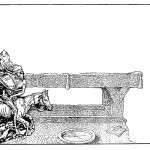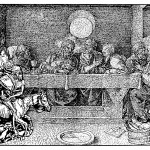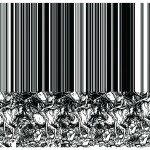The medition as an art. The art as a form of shelter.
Andrzej Dudek-Dürer considers himself to be the reincarnation of Albrecht Durer, who was born in Germany in 1471. Such a definite statement makes both the critics and the recipients helpless, for they have rejected the possibility of the „wheel of life and death”, or they take it as a joke or even “Witkacowska blagę”. No, although this category is important in the newest creative activities it is not relevant for him. Andrzej Dudek-Dürer creates a certain fact of psychological and artistic nature, which through the performance of the meditation character creates an energy bond between all of his works, created in various techniques. The interpretation of the performance in the relevant manner as a form which also serves as the intercessory prayer for the dead artists (creation of symbolic forms, providing the shelter, like a circle, lighting of the candle, playing sitar), and at the same time as the declaration of abandonment of one’s own and defined identity, related to the paratheatral form of live action, which for many years now distinguishes this artist from creators who are showing only the grappling with the specific form or space or an attempt to melt an art in life, which is the old avant-garde utopia, best defined and disclosed by the Fluxus movement. Polish performance lacks actions which would create a certain structure of time and ideology and in that sense it is absent from such important figures as there were in 70th and 80th. How to describe the attitude of artist, for it is always essential? Andrzej Dudek-Dürer does not struggle with anyone, he does not even want to compete, at most, with his realizations he reminds about his place on the map of Polish art. Depending on the necessity, he is a photographer, a graphic designer, a creator of the video, who can use in a practical way every moment of life to create something which is not only intriguing, but can turn his travels, thoughts and ideas into an art, which is a form of meditation, including the symbolic problem. Almost like a Buddhist monk creates mandalas from sand, Andrzej Dudek-Dürer with the assistance of his performance can create important psychological bonds between people, always linked with his efforts to struggle with the substance, which is the characteristic of his activities. In this sense, he is a traditionalist, even though he follows his generation brought up in conceptualism, thus he is a pupil of the late artistic modernism, but he was never connected to the avant-garde rhetoric of purism, minimal art and conceptualism or radical body-art, and who, what is worth considering, has had his best years a long time ago find himself in the activities Vienna’s activists. His works on photography, graphics and video serve him as ways to reckon himself, his concerns and even obsessions which need to be neutralized. The Performance, as I remember it from 1994, when I first saw it in Wili Herbst, which belonged to the Museum of Art in Lodz in October 1994, is a form of meditation. For example in graphics he shows the Apocalypse without death, thus working on the famous work of Dürer, which relates to the vision of the contemporary German artist of the late fifteenth century, as well as having a dimension of the final battle „between the good and the evil”. Wroclaw’s artist does not want to neglect the dimension of Apocalypse, but rather to deprive it of the dimension of tragedy. Does the artist have such power? He wants to calm the works of the German artist of the late Middle Ages and Renaissance; he wants to give them a more humanistic impression, without fear and trembling, so strongly accented in the famous Apocalypse series. One might ask whether the apocalypse is still important, if it is only brought to the dimension of the film of Armageddon (1998) type and is its dimension only the annihilation? I have talked with the artist about this issue during the interview: “The Awareness transformation” . And here is the interesting part: K. Jurecki: Apocalypse in your interpretation appeared even on the toilet paper or being sealed in a glass jar! Andrzej Dudek-Dürer: 70th and 80th of XX century in PRL both for artists and Polish society was a hard period of time, due to the difficulties in the acquisition of different goods. For artists, these problems were related with the inability to purchase graphic inks (for various graphic techniques), fine art papers, brushes, and photo paper (with specific parameters), in some ways this was a better period than 60th. In that period of time the special shops were created for the artists, where from time to time something was being “thrown”. In such conditions, the works were created for example on the toilet paper (which at that time, could not be easily purchased, the Apocalypse on the toilet paper, object, 1978), the others on daily newspapers, wallpaper, sandwich paper, tissue papers, boards, or so called contours for the youth … and on many, many other materials. I believe that if the author is creative he is able to adapt various aspects of the so-called everyday reality and transform these aspects into a formula of creativity. At that time I developed a recipe for several types of graphic inks, including the one for serigraphy. The interest in oldfashioned chromatin techniques resulted from the need to be independent from the market of photographic materials. Apocalypse on the toilet paper is a manifestation of the threat, the manifestation of transience and impermanence of all so-called materiality, it is a mode of paradox of existence, which reveals both the circle of birth and death, is a reflection of the values and qualities of life. Apocalypse in the jar has similar reference. The work with the jar was evoked under the martial law. Transparent jar and hidden hazard inside, which may be released – is a reflection mode over decisions. So is it the Pandora’s Box? Yes, the random action may cause the unpredictable consequences. Toilet paper is a symbol of something very mundane, something which is rapidly degenerating and degradating. It should be added that this paper was not available then, however on the other hand as already pointed out the artist can and should work on anything. You do not know my works on the wallpaper, in which I exercised the serigraphs. You should be aware only of the action of each matter, with which you work as well as have the understanding about the possibility of rapid degradation. It can be seen in the context of the current civilization, which inundates us with various gadgets and trinkets. Apocalypse, which can be understood in a broader and more universal manner, appeared in my photography in the early 70s – these were the pictures of garbage dumps, old neglected cemeteries (Crosses series, which at that time were not available for the presentation to the public due to the restrictions posed by censors). The documentation of performance Autocrucifixion (1973) was rejected to be shown in an exhibition on the grounds „that these fights are decadent and defeatist” and „this type of work may hurt one’s religious feelings”. The current cultural situation resembles one of the late nineteenth century, when Oscar Wilde published The Picture of Dorian Gray (1890), as an expression of the concept of „art for sake of art’s”, which was liberated from the certain rules of the academic art. For Wilde’s the following footsteps of the Romantics were treated only for the hedonistic beauty and fulfillment of their hedonistic desires. Let’s take a brief, but very characteristic quote, expressed in the answers of Lord Henry Wotton: What about the Art? – She asked. It is a disease What about the Love? It is a disappointment What about the Religion? It is a refined surrogate of faith” One might say that this is a characteristic of postmodern religious modernism, in terms that Wolfgang Welsch offered no culture opposition for the two eras, but rather a mutual interpenetration, in which the current post-modernism, of course not in all aspects and manifestations of art, can be separated from the modernism of XX century, but not avant-garde. Completely different attitude is represented by Andrzej Dudek-Dürer, although of course it takes place in times of post-modernity, to some extent under the pressure of the latest digital technology. However in many studies of the XXI century he refers to the archetypes of Christ, Buddha, shows that the art creates miracles (levitation) and transmits the spiritual energy and gesture greetings to all. Thus he realizes the fight against stigma of death, which was the practical task of the art in virtually all systems and religious practices from the very beginning of the Homo sapiens era. In addition his art makes him to distinguish the faith, which is deprived of the „aura” from any postmodern images that the condition created by a religious creator, who lives according to the certain ethical rules, has the potential power of influence over the world. This category, which is inherently included in many works of Andrzej Dudek-Dürer, will mean that the power impact of his paintings, as I consider, will grow over the time. Of course it also contains some aspects of postmodern irony, although quite rare, which weakens the sacred images. The spiritual power of the art is also trying to annihilate the ubiquitous ideologization and politicization of the art in favor of the sanctity of the human and the whole world, understood as a „form of energy.” However it is a form of individual religious syncretism, without specific reference to the formula of Buddhism or Hinduism. Without the expansion and overemphasis on the ideological layer in order to create a shelter: for yourself, for people, including the famous deceased artists. One might say that this is a mode of creativity as a shelter, namely, the mandala. The shelter from destruction, the shelter from annihilation in order for the final liberation from the circle of birth and death to come.
Krzysztof Jurecki



